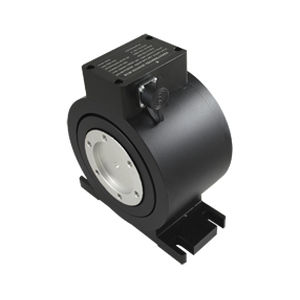Model 1816 is a rotating torque transducer (RTT) with air bearing during rotation, in order to measure rotary torque up to 20,000 Newton-meters (20 kNm). It consists of a rotor and a stator: the rotor acts as a measuring shaft of torque, while the stator supplies electric power to the rotor and transmits torque signal from the rotor to a SSC (sensor signal conditioner).
Thanks to adaptation of the electromagnetic induction principle, model 1816 RTT has no electric brush between the rotor and the stator for the power and signal transmission. In addition, as one of the advantages of the air bearing the rotation of this RTT does not need any mechanical bearings at all. As a result, model 1816 is an ideal device for applications which require long term durability and very few maintenance.
The measuring torque capacities of 1816 RTT can be minimum 5 Nm and of maximum 20 kNm with accuracy of 0.5%fs. Its output signal is ±6Vdc square wave frequencies, ranging from 5 kHz to 15 kHz for each of the torque capacities. Upon request, this 1816 RTT can be integrated with a speed sensor to measure rotor’s speed. The rotor speed is measured by means of a tachometric wheel of the speed sensor at a rate of 60 pulses per revolution.
This RTT is designed for bidirectional (both clockwise and counterclockwise) torque measurement. Nevertheless, it can be also used for unidirectional (either clockwise or counterclockwise) torque measurement as well.
When 1816 RTT is installed in torque measuring systems, the input end of its rotor will be connected to the output end of a gear box of motors or engines, while its output end will be connected to the input end of a load like a water pump.


